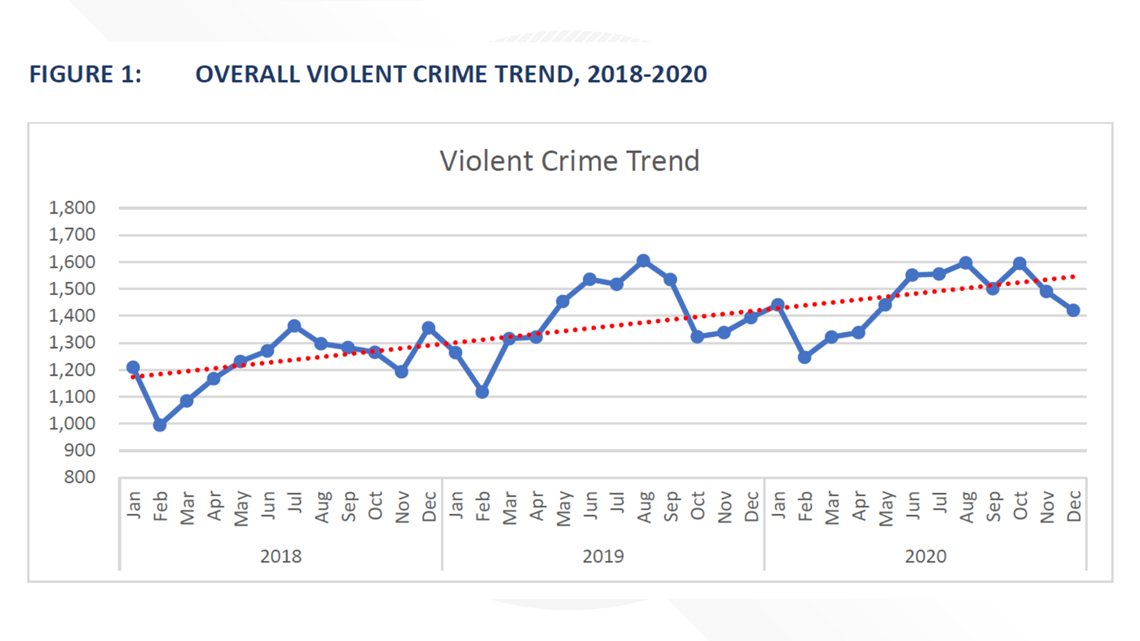DALLAS —
This story was updated at 7 p.m. Wednesday following interview with Chief Garcia.
Dallas Police Chief Eddie Garcia presented his 2021 violent crime reduction plan to Dallas City Council on Wednesday to reduce violent crime in the city's most violence-prone areas.
Garcia, who took over as chief earlier this year, has emphasized how police departments need buy-in from the community to help reduce violent crime. During a public interview for the position, he mentioned hotspot policing and other evidence-based strategies to bring crime down and decrease the number of victims in Dallas.
Now he presented his plan at a 9:30 a.m. council briefing Wednesday. There was general support for the plan from council members.
Overall violent crime in Dallas is on the rise. Garcia's plan outlines strategies like targeting high-crime hotspots, community-based solutions like partnering with other community groups, law enforcement and city services, and physically changing those high-crime areas, such as by adding green spaces and fixing blighted buildings.
Some council members were concerned that the hotspot policing strategy in the plan could shift officers from other areas to the hotspot high-crime prone areas. Garcia reiterated that officers are not leaving other areas. Crime has been rising in all areas of the city.
“In the past three years, violent crime has increased steadily with a 14% increase from 2018 to 2019 and an additional 5% increase in 2020 compared to 2019,” the plan says.
In March 2021, there were 12 homicides and 469 aggravated assaults, both of which were increases over 2020 year-to-date data, according to the police department. Aggravated assaults and homicides continue to be the department's primary area of concern.
Violent crime in Dallas, like in most cities, is geographically concentrated in a relatively small number of areas within the city, the plan says.
For example, just 14 of Dallas’ 1,156 reporting areas account for 10% of the City’s reported violent crime, the plan says.
Hotspot policing
This is the department's short-term focus. The department currently has a hotspot strategy but the department intends to modify its approach, the plan said.
Garcia said Wednesday that the goal is higher police visibility in those areas and the direction of enforcement on repeat offenders.
The department can increase police presence at “micro-locations where violent crime is concentrated” by “prioritizing street-level deterrence and arrest of repeat offenders in these areas,” the plan says. The micro-locations will be made of 330-feet-by-330-feet grids.
"The strategy is evidence-based and relies on increased police visibility and intelligence-led offender targeting rather than generalized 'stop and frisk' or other dragnet tactics," the plan says.
Data for the hot spots, including crime and calls for service, will be reviewed every 90 days and any necessary adjustments will be made.
The department’s seven patrol divisions are currently divided into 225 beats. The same four beats have been among the top five violent crime areas in the city across a 10-year period, the report says.
Historically, beats 318 (Southeast Division), 454 (Southwest Division), 744, and 731 (South Central Division) have consistently ranked as the most violence-prone in Dallas.


Placed Network Investigations
The plan introduced Placed Network Investigations, which look at how “unguarded places” are used by individuals and criminal networks to facilitate crime. It identifies where criminal networks meet and disrupts them.
A PNI board will help create place-based strategies to address crime and its causes within the identified crime-place network. The board will be made up of stakeholder government agencies (e.g., code enforcement, health departments, parks & recreation) and non-profit and/or community-based groups, the plan says.
"We are going to be there for them [residents] and be focused and not just on weeding but seeding," Garcia said Wednesday. "We must try just as hard in the outreach so they know what we’re not doing -- just as much as we are weeding criminals out."
The department's traditional police efforts will be coordinated with the city’s Office of Integrated Public Safety Solutions and coupled with efforts, like code enforcement, abatement, environmental design changes, disorder-focused efforts (graffiti abatement, trash clean up, abandoned vehicle removal, weed/brush removal) and other efforts to alter the criminogenic nature of the entire crime-place network, the plan says.
“As crime declines in the targeted areas, new place networks will be identified and brought into the strategy,” the plan said.
PNIs have shown early signs of promise in Cincinnati, Las Vegas and other cities, according to the plan.
Longer-term deterrent strategies
The plan says longer-term strategies include working with other city agencies to implement a vacant lot “greening” program and vacant/dilapidated building abatement strategy.
“First designed and implemented in Boston in the 1990s, focused deterrence strategies have proven successful in reducing violent crime in a number of cities where they have been applied and evaluated,” the plan says.
The department also said that there is growing literature that shows the association between urban blight and crime, including violent crime.
The report says that Philadelphia saw success in reducing violent crime through low-cost efforts like “greening” vacant lots and repairing facades of abandoned and neglected buildings.
DPD will coordinate the implementation of an urban blight abatement strategy in accordance with the Dallas Mayor’s Task Force on Safe Communities recommendations.
Focused deterrence
Focused deterrence is focusing on the right individuals, such as trying to deter them from engaging in violent crime.
“The goal of focused deterrence is to change the behavior of high-risk offenders through a combination of deterrence, incapacitation (arrest), community involvement, and the provision of alternatives to violence," the plan said.
The strategy communicates to gang members and other violent offenders of the risks associated with continued criminal activity and the alternatives available to them “under a robust suite of social services, education, and job-related services made available to them under the strategy.”
Initially, the DPD will work with research partners, city leadership, and other stakeholders to prioritize problems for focused deterrence interventions, including law enforcement, community partners, federal law enforcement and the U.S. Attorney’s Office.
The city's violence interrupter strategy is following other successful models, the report said. They will help resolve street-level conflicts among violence-prone offenders.

